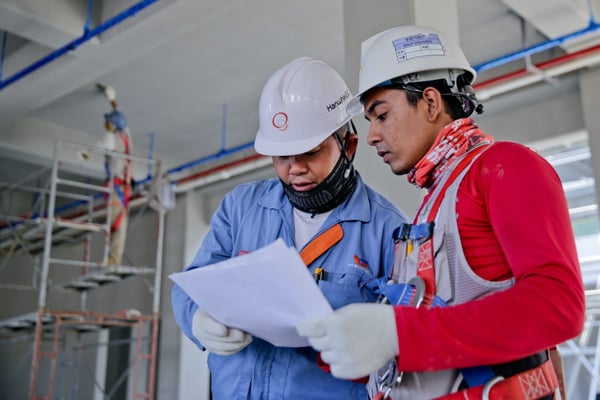Construction equipment is necessary for certain tasks on a job site to be completed. In this installment of a four-part series, we will cover a few miscellaneous pieces of equipment - this is not an exhaustive list. This equipment includes gas masks, gas detectors, respirators, items to help prevent falls and ergonomics equipment. While these pieces of situational use equipment may not be needed or appropriate for every job, they are important to a variety of tasks. Understanding when situational use equipment is needed and how to use it appropriately is key to the success of the project.
Gas Detectors
Gas detectors can be a vital piece of equipment to have on a job site. Many job sites will have the gas to the area shut off or disconnected while construction is happening, but there are detectors that do more than just look for carbon monoxide. Those detectors look for oxygenation problems (too much or too little) which can be caused by non-toxic air contaminants. Oxygen deficient buildings pose a suffocation hazard and impact the respiratory system in seconds. Oxygen enriched environments increase the risk of combustion of flammable gases.
While carbon monoxide detectors are important, it is a good idea to look at detectors which search for other air quality problems. Too much or too little of certain gases can cause a number of problems for the workers on the project, plus detecting these problems before a job is done provides security for the buyer that all known issues have been resolved upon project completion. Be sure to research the current detectors available to ensure you are getting what you need, and be sure to follow manufacturer’s instructions for use to eliminate mis-reads and errors.
Gas Masks and Respirators
Depending on the type of job you are doing, it might be a good idea to have a gas mask or respirator for protection. The human respiratory system is very sensitive to outside toxins and is the number one way we contract illnesses. Environmental Design + Construction says, “One important thing you have to take note of is that various respirators also suit various kinds of jobs. While some utilize respirators equipped with chemical cartridges, other users wear those equipped with a particular filter.” They also compiled a list of the top respirators for 2020.
The bottom line here is to do your research. Know what hazards you will be exposed to on a given job site and learn which respirator provides the best protection. And always follow the manufacturer’s instructions for appropriate fit and proper use.
Fall Prevention
According to the Occupational Safety and Health Administration (OSHA), “FALLS ARE THE LEADING CAUSE OF DEATH IN CONSTRUCTION. In 2018, there were 320 fatal falls to a lower level out of 1,008 construction fatalities (BLS data). These deaths are preventable.” They are preventable when employers provide the proper fall protection for their employees AND the employees utilize said protection according to the manufacturer’s guidelines.
OSHA instituted a fall prevention campaign which has three steps: Plan, Provide and Train, which is outlined on their website. Safety and Health Magazine further outlines this campaign and states, “If you are working at 6-feet or higher, you need fall protection.”
Fall protection includes harnesses with places to tie off, ladders, scaffolds and safety gear like hard hats. As an employer, you are required to provide this safety equipment to your employees who need it. You must provide proper training on each piece of equipment to ensure proper use. As stated in the OSHA campaign, planning the equipment required for each job is imperative to the safety of your employees and ensures completion without delays due to injury.
Construction is a dangerous profession with many safety hazards. It is paramount that you know what is required for each job so that proper equipment can be provided to your employees. Knowing when situational use equipment is needed is imperative to the safety of your workers. It not only protects your employee’s life and livelihood, but it protects your business from potential litigation when guidelines are not followed.

Recent Posts
- Spec Home Loans: Complete Guide to Construction Financing for Builders
- Spec Construction Loans: A Spec Line of Credit Is Worth the Paperwork
- Spec Homes and Pre-Sale Homes: Relative Benefits for a Spec Builder
- Spec Construction Success: Insights for the Investor Builder
- How Is a Spec House Different From Other Kinds of House Construction?
